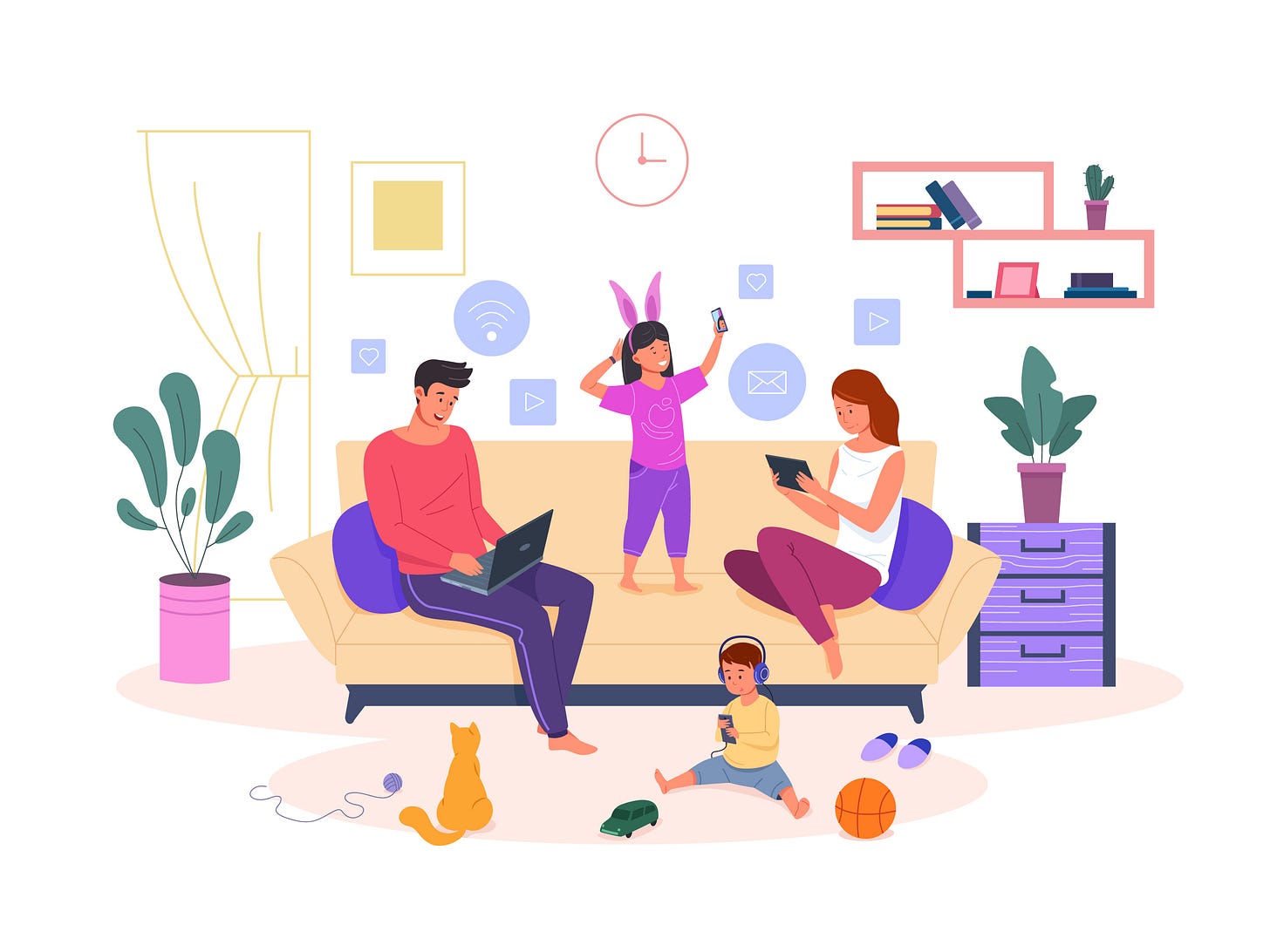AI for Kids: How to Use AI to Make Parenting Easier and More Fun
Discover AI-powered activities, games, and learning tools to keep kids engaged—without more screen time.
Every parent knows the struggle: your child has been staring at a tablet for hours, then sighs dramatically when you mention homework, only to declare "I'm bored!" five minutes later. It's the never-ending paradox of modern parenting that somehow leaves everyone frustrated.
But what if AI could help out—not by replacing your parenting (sorry, no robot babysitters yet), but by becoming your creative partner? Imagine having an instant idea generator for rainy day activities, a storytelling partner for bedtime, and a homework translator that finally makes fractions click for your child.
AI isn’t here to outsource fun or learning. Instead, it’s a tool that helps you and your child explore, create, and learn together. Whether it’s crafting scavenger hunts, designing backyard adventures, or turning math homework into something that actually makes sense, AI can make life a little easier and a lot more interesting.
Let’s look at how AI can help keep kids entertained, engaged, and maybe even excited about learning.
AI-Powered Screen-Free Activities
Kids love their screens, but sometimes, parents just want them to do anything else. The problem? Thinking up fun, engaging activities on the fly is exhausting—especially after a long day of work, chores, and everything in between.
That’s where AI comes in. And it doesn’t have to stop at rainy-day activities—AI can also spark creativity for bedtime stories and imaginative role-play.
AI as a Creative Brainstorming Partner
Parents don’t always have time to be full-time activity coordinators, and that’s okay. AI can help by generating ideas tailored to your child’s age, interests, and available supplies.
Example Prompts to Try:
“What are some creative outdoor activities for a 7-year-old who loves dinosaurs?” You might get a DIY fossil dig, a backyard Jurassic scavenger hunt, or a dino-themed obstacle course.
“Give me five unique arts and crafts projects for a rainy afternoon using just paper, glue, and markers.” AI could suggest pop-up storybooks, homemade board games, or even shadow puppets with a DIY flashlight show.
“I have a 10-year-old who’s obsessed with space. Can you suggest a hands-on science experiment we can do at home with basic supplies?” Expect ideas like making a baking soda rocket, creating a planetarium in a dark room, or simulating craters with flour and marbles.
“Invent a brand-new backyard game for my kids (ages 6 and 9) using pool noodles and a soccer ball.” AI might suggest “Noodle Knights,” a mix of soccer and tag where players must defend their castle (a marked-off area) using only their pool noodles.
The key is to treat AI as a brainstorming partner, not a dictator. If it suggests something too complicated (because let’s be real, nobody is building a full-scale dinosaur dig site in their backyard), tweak the idea into something doable. AI provides the spark—you decide how big the fire gets.
AI-Generated Storytelling & Role-Playing
Once you've got your kids away from screens and engaged in an activity, you might face another common parenting challenge: creativity on demand. Bedtime stories and pretend play are magical parts of childhood, but let's be honest—not every parent has the energy to come up with yet another adventure about a heroic squirrel saving the forest AI can help by co-creating stories and role-playing scenarios that keep kids engaged while sparking their creativity.
Custom AI-Generated Bedtime Stories
Instead of reading the same book for the hundredth time, try asking AI to create a fresh, personalized bedtime story.
Example Prompts:
“Tell me a bedtime story about a girl who finds a secret portal in her backyard. Make it adventurous but not scary.”
“Create a funny bedtime story featuring my son Liam, a talking cat, and a lost spaceship.”
“My 5-year-old loves unicorns and trains. Can you blend those into a short bedtime story with a positive lesson?”
Many AI chatbots can generate full stories in seconds, but the real fun comes when kids help shape the plot. Ask follow-up questions like:
“What happens next?”
“Should the hero take the left or right path?”
“What do you think the treasure will be?”
This turns story time into a collaborative adventure rather than just passive listening.
Pro Tip: Plan Ahead!
You don’t have to wait until bedtime to scramble for a story idea. Ask AI to generate a few in advance and save them in a dedicated file on your computer or print them out to keep in a story binder. This way, you always have fresh tales ready when needed.
Role-Playing Adventures & Pretend Play
AI can also help design pretend-play scenarios where kids become knights, superheroes, or explorers in their own backyard.
“My kids want to play superheroes. Can you create a fun mission for them to complete?” AI might suggest a daring rescue operation or a hunt for a hidden villain’s lair.
“We’re playing castle. Can you create a royal mystery for my kids to solve?” Maybe a mischievous dragon stole the kingdom’s golden goblet, and the young knights must uncover clues to track it down.
“Give me a space exploration game for my 6-year-old and 8-year-old to play outside.” → AI might suggest that they’re astronauts on a mission to find new planets, with different backyard areas representing uncharted worlds.
Just tell AI what your child loves, and you'll get fun, new ideas without having to think them up on the spot.
Pro Tip: Build an AI Activity Binder
Instead of coming up with new ideas on the fly, parents can pre-load a “Fun Ideas” folder on their computer or print an activity binder filled with AI-generated storytelling prompts and role-play scenarios. When kids are looking for something to do, just flip through the options and pick one that fits the moment.
Custom Game Creation
Sometimes, the classic games just aren’t cutting it—kids get bored of the same old board games, scavenger hunts, or trivia questions. Instead of buying a new game every time, parents can use AI to refresh existing ones or create something entirely new.
AI-Tweaked Classics
AI can modify traditional games to make them more engaging, adding personalized twists based on your child’s interests.
“Can you create a new rule for Uno that makes it more fun for my 9-year-old?” AI might suggest a “Draw Two Swap” rule where players can trade hands after drawing two cards, or a “Secret Wild” that lets players create their own special rule.
“Give me a way to make Monopoly more exciting for younger kids.” AI could suggest a speed round with shorter playtimes or “mystery cards” with surprise challenges like “Do a silly dance to earn $100.”
“My kids love scavenger hunts. Can you design one for a rainy day inside?” AI might create a “Detective Mystery Hunt” where each clue reveals part of a bigger mystery, turning a regular scavenger hunt into an interactive story.
By tweaking small elements of familiar games, AI helps keep playtime fresh without requiring parents to reinvent the wheel.
Completely New Game Ideas
If your kids are up for something totally different, AI can help generate brand-new games from scratch.
“Can you invent a new outdoor game using a soccer ball and cones?” AI might suggest “Soccer Maze,” where players dribble through an obstacle course while completing mini challenges at each checkpoint.
“Create a silly family game we can play after dinner with no extra materials.” → Try “Reverse Rhyme Time”—one player says a word (banana), and the next person has to come up with a word that doesn’t rhyme with it, but sounds like it should (bandana). The first person to mess up gets a silly challenge.
“My kids love superheroes. Can you invent a game where they create their own hero and complete a challenge?” → AI might generate a “Hero Training Camp” where kids earn powers by completing different challenges, like running an obstacle course to gain super speed.
Pro Tip: Keep an AI Game List
Just like with storytelling and role-playing, parents can build a file or binder of AI-generated game ideas to keep on hand. Next time boredom strikes, just pull out a ready-made game suggestion—no stress required.
AI as a Homework Partner (Not Just a Helper!)
Homework time: the moment when kids suddenly remember they’re starving, exhausted, or need to clean their room immediately. While AI won’t eliminate the struggle entirely, it can make learning more engaging and less stressful—for both kids and parents. The trick is to use AI as a learning partner, not just a shortcut.
Gamifying Learning Together
Many AI-powered tools turn studying into a game, making it feel less like a chore and more like a challenge to beat.
“Can you create a fun quiz to help my 8-year-old practice multiplication?” AI might generate a “math battle” where kids race against the clock to defeat an imaginary villain by solving problems.
“My kid is struggling with history. Can you turn the American Revolution into an interactive game?” AI could suggest a role-playing adventure where kids play as spies delivering secret messages between revolutionaries, learning key events along the way.
“Give me a way to make vocabulary words more fun.” Try “Vocab Swap”—AI gives you a list of synonyms, and your child has to guess the original word. Or let AI generate a short story where they have to find and replace words with their vocabulary list.
The key is to engage with the AI-powered tools rather than just handing them over to your child. By participating in the games, parents reinforce learning as something fun and interactive.
Breaking Down Tough Concepts—Together
Sometimes kids just don’t get it, and explaining things in a way that finally makes sense can feel impossible. AI can help by rewording complex topics in different ways until something clicks.
“Explain fractions to a 10-year-old using a pizza analogy.” → AI might describe how dividing a pizza into slices is just another way of talking about fractions, making the concept more tangible.
“Describe gravity like a superhero power.” → AI could frame it as an invisible force that keeps everything on Earth from floating away, just like how superheroes can control objects with their minds.
“My child loves drawing. Can you explain the water cycle in a way that would make a great comic strip?” → AI could break it down into scenes, suggesting a character named Drippy the Raindrop going through evaporation, condensation, and precipitation.
Interactive Problem-Solving
Some AI tools do more than just explain—they show step-by-step solutions, making it easier to grasp tricky subjects.
Photomath & Wolfram Alpha: Take a picture of a math problem, and these apps break it down step by step—great for showing how to solve it rather than just giving an answer.
AI Writing Prompts: Instead of staring at a blank page, ask AI for fun writing prompts to get ideas flowing.
“Give me three silly writing prompts for a short story about a talking sandwich.”
“Help my 7th grader start a persuasive essay on why school should start later.”
Pro Tip: AI as a Thought Partner, Not a Crutch
AI can be a powerful learning tool, but it’s important to make sure kids are thinking rather than just copying. Encourage them to:
Ask AI to explain why an answer is correct.
Compare multiple explanations to see which makes the most sense.
Use AI-generated quizzes or flashcards to test what they’ve learned.
AI isn’t here to replace learning—it’s here to make it click.
AI as a Family Connection Tool
AI isn’t just for homework and play—it can also help families spend more quality time together. From planning fun outings to sparking interesting dinner-table conversations, AI can be a surprising ally in making everyday life run more smoothly.
Planning Fun Together
Parents juggle a lot, and sometimes, planning activities feels like yet another chore. AI can help generate ideas that fit your family’s schedule, budget, and interests.
“Give me a fun family outing idea for a Saturday afternoon that’s budget-friendly.” AI might suggest a DIY park scavenger hunt, a free museum day, or a backyard picnic with a twist (like letting kids be the chefs).
“Help me plan a themed family dinner night with food, decorations, and a simple game.” AI could suggest a “Space Night” with galaxy-themed snacks, astronaut costumes, and a trivia game about planets.
“It’s a rainy weekend—give me three unique ideas for indoor family fun.” AI might suggest building a “couch fort escape room,” hosting a silly talent show, or creating a “mystery box” challenge where family members have to guess objects by touch.
Having a bank of AI-generated ideas on hand means fewer “I don’t know, what do you want to do?” conversations.
Teaching Kids About AI While Using It
AI is shaping the world kids are growing up in, so helping them understand how it works—and how to use it wisely—can be a valuable skill.
“Ask ChatGPT to generate five riddles, then see if we can guess the answers together.”
“Let’s test AI’s creativity! We’ll each give it the same silly writing prompt and see whose story turns out the best.”
“Let’s play ‘AI Fact or Fiction’—we ask AI a question, and then we fact-check the answer together.”
The goal isn’t just to use AI, but to help kids think critically about it. Is AI’s answer always correct? Does it sometimes get things wrong? By engaging with AI together, kids learn to approach technology with curiosity and a healthy dose of skepticism.
Pro Tip: Let AI Help with Family Organization
AI can also help parents stay on top of things:
Generate a weekly meal plan based on what’s in the fridge.
Create a shared family to-do list with reminders.
Suggest age-appropriate chores to keep kids involved.
When used intentionally, AI can free up more mental space—so parents can focus less on logistics and more on enjoying time with their kids.
Conclusion
AI isn’t here to take over parenting—it’s here to make things a little easier. Whether it’s coming up with fresh activity ideas, turning homework into a game, or helping families spend more quality time together, AI can be a surprisingly useful tool.
The key is to use AI with your kids, not just for them. Let it help spark creativity, problem-solving, and fun while keeping the focus on real-world connection.
So why not try it out? Pick one AI-powered activity this week—whether it’s generating a bedtime story, planning a scavenger hunt, or using AI to explain a tricky homework question—and see what works best for your family.
And if you discover a particularly great AI-assisted parenting hack, share it in the comments! Let’s learn from each other and keep making life just a little bit easier.




